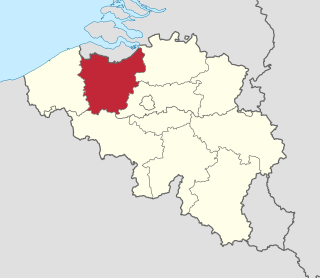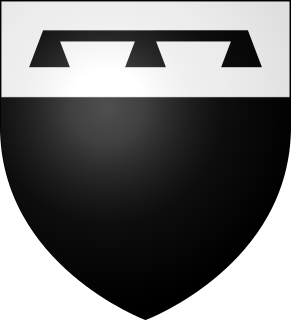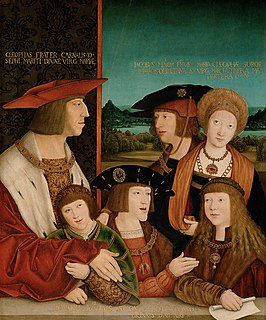This article needs additional citations for verification .(July 2017) (Learn how and when to remove this template message) |
Lambert de Briarde, Lord of Liezele sometimes Lambrecht van den Bryaerde (died 10 October 1557 [1] ) was a Flemish judge.
This article needs additional citations for verification .(July 2017) (Learn how and when to remove this template message) |
Lambert de Briarde, Lord of Liezele sometimes Lambrecht van den Bryaerde (died 10 October 1557 [1] ) was a Flemish judge.
His family belonged to the old nobility dating from the 13th century. He was born in Duinkerke, the youngest son of Andries de Briarde, Lord of Coye. His older brother Charles was mayor of the Brugse Vrije. Lambert was married to Marguerite Micault. They had two children:

The Brugse Vrije was a castellany in the county of Flanders, often called in English 'the Franc of Bruges'. It included the area around Bruges, and was bordered by the North Sea, the Westerschelde and the Yser river. The city of Bruges was separated from the castellany in 1127. Since then the city and the Vrije were considered as separate customary law areas. The Brugse Vrije was a rich agricultural region. It had its own burgrave, who was seated at the Burg, a square in Bruges, and became part of the Four Members of Flanders at the end of the 14th century, together with the three major cities of Ghent, Brugge and Ypres. The Brugse Vrije sat in the meetings of the States of Flanders.
He obtained a degree of Doctor in Canon Law in Louvain and started a career in Flanders. In 1519, he was advocatus in the Council of Flanders in Ghent, where he participated in major cases. He became master of requests of the Great Council in 1522, and was promoted to President in 1532 by request of Charles V until his death. He served almost a quarter of a century as President
Besides his career he was sent on diplomatic missions in service of the Emperor and the governess Margaret of Parma. He was sent to negotiate during the Revolt of Ghent.

Margaret of Parma was Governor of the Netherlands from 1559 to 1567 and from 1578 to 1582. She was the illegitimate daughter of the then 22-year-old Holy Roman Emperor Charles V and Johanna Maria van der Gheynst. She was a Duchess of Florence and a Duchess of Parma and Piacenza by marriage.

The Revolt of Ghent was an uprising by the citizens of Ghent against the regime of the Holy Roman Emperor and Spanish king Charles V in 1539. The revolt was a reaction to high taxes, which the Flemish felt were only used to fight wars abroad. Charles marched his army into the city the following year and the rebels surrendered without a fight. Charles humiliated the rebels by parading their leaders in undershirts with hangman nooses around their necks. Since then Ghent citizens informally call themselves "noose bearers".
He is buried in St John of Mechelen.
| Government offices | ||
|---|---|---|
| Preceded by Nicolaas Everaerts | 4th President of the Great Council 1532–1556 | Succeeded by Nicolaas II Everaerts |

Philip the Bold was Duke of Burgundy and jure uxoris Count of Flanders, Artois and Burgundy. The fourth and youngest son of King John II of France and his wife, Bonne of Luxembourg, Philip was the founder of the Burgundian branch of the House of Valois. His vast collection of territories made him the undisputed premier peer of the kingdom of France and made his successors formidable subjects, and sometimes rivals, of the kings of France.

East Flanders is a province of Belgium. It borders the Netherlands and the Belgian provinces of Antwerp, Flemish Brabant, Hainaut and West Flanders. It has an area of 2,991 km², divided into six administrative districts containing 60 municipalities, and a population of 1,408,484. The capital is Ghent.

Joan, often called Joan of Constantinople, ruled as Countess of Flanders and Hainaut from 1205 until her death. She was the elder daughter of Baldwin IX, Count of Flanders and Hainaut, and Marie of Champagne.

Theoderic, commonly known as Thierry of Alsace, was the fifteenth count of Flanders from 1128 to 1168. He was the youngest son of Duke Theoderic II of Lorraine and Gertrude of Flanders. With a record of four campaigns in the Levant and Africa, he had a rare and distinguished record of commitment to crusading.

Arnulf of Flanders, called the Great, was the first Count of Flanders.
Frans Ackerman, sometimes given as Franz, Francis or French Ackerman, was one of the most famous Flemish statesmen of the 14th century.

Louis II of Flanders, also known as Louis of Male, a member of the House of Dampierre, was Count of Flanders, Nevers and Rethel from 1346 as well as Count of Artois and Burgundy from 1382 until his death.

Maurice Auguste Count Lippens was a noble Belgian businessman, politician, and colonial civil servant and lawyer.

Poeke Castle is a castle near Poeke, a small town in the municipality of Aalter in the Belgian province of East Flanders. The castle, standing in 56 hectares of park, is surrounded by water and is accessible through bridges at the front and rear of the building. Poeke Castle is situated at an elevation of 15 meters.

Claude de Berlaymont, lord of Haultpenne was a Flemish military commander in Spain's Army of Flanders during the Eighty Years' War.

On 23 August 1328, the Battle of Cassel took place near the city of Cassel, 30 km south of Dunkirk in present-day France. Philip VI, fought Nicolaas Zannekin, a wealthy farmer from Lampernisse. Zannekin was the leader of a band of Flemish independence rebels. The fighting erupted over taxation and punitive edicts of the French over the Flemish. The battle was won decisively by the French. Zannekin and about 3200 Flemish rebels were killed in the battle.
Zeger III of Ghent was the lord of Heusden, of Bornhem, and of Saint-Jean Steen, and the Châtelain of Ghent. He was the second son of Zeger II, Lord of Ghent and Petronella of Coutrai. His older brother, Arnold, died before 1190, leaving him the heat to the estate of his parents. He took his title of lord of Ghent, Bornhem, and Saint-Jean Steen around 1199. He married Beatrix of Heusden, and through her became Lord of Heusden, a title which was held by his son and progeny.

Vilain and Vilain XIIII is a Belgian noble family. Their coat of arms is basically "sable, au chef d'argent", a colour scheme that is present from the earliest Vilains in the 15th century, and is also seen in the Vilain XIIII arms, which have the "XIIII" added to it.

In the period 1482–1492, the cities of the County of Flanders revolted twice against Archduke Maximilian of Austria, who ruled the county as regent for his son, Philip the Handsome. The revolts were rooted in the cities' desire to maintain the autonomy that they had wrested from Philip's mother and predecessor, Mary of Burgundy, which Maximilian threatened to curtail. Both revolts were ultimately unsuccessful.
Pierre Roose, lord of Froidmont, Han and Jemeppe, was president of the Brussels Privy Council from 1632 to 1653, and a key actor in the government of the Habsburg Netherlands for over twenty years.

Charles Joseph Marie d'Hane Steenhuyse was a Belgian politician. He was a landowner and rentier, liberal Schepen in Ghent and a Catholic MP.
Jean Alphonse, 1st Count de Coloma, was a Flemish noble lord of Spanish descent. He was a member of the Great Council of Mechelen, of the supreme council in Vienna, and president of the Brussels Privy Council.

Henri IV de Vicq, Lord of Meuleveldt, was a Flemish Ambassador and became President of the Great Council of Mechelen
Hyachinthe-Marie de Brouchoven (1650-1707), Lord of Steen and Spy, was a Flemish nobleman who became president of the Great Council of Mechelen.

Guillaume-Albert de Grysperre, baron of Goyck and Libersart (1637–1725) was a Brabantine noble lord who was awarded the title of baron de Grysperre in 1691.
| This biographical article of a European noble is a stub. You can help Wikipedia by expanding it. |